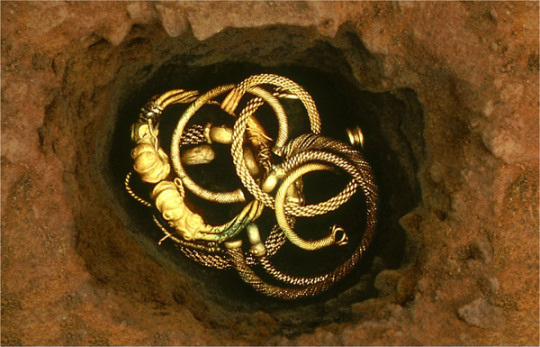For over 2,000 years, hundreds of gold and silver torcs lay hidden in a Norfolk field discovered by one man and his metal detector.
Maurice Richardson has brave all weathers with his reliable metal detector for 40 years and dreams of the buried treasure. But he almost ignored an unpromising beep when he was searching for waste from a wartime air crash while he was being pelted with rain.
However the 59-year-old is glad his curiosity got the better of him after his persistence in digging through more than two feet of Nottinghamshire mud yielded a stunning 2,000-year-old gold treasure.
Now the artifact, an Iron Age torc, has been sold for a mammoth £350,000, and it was unveiled at the British Museum as the most valuable discovery in recent times.

The intricately decorated collar was so perfect that Mr. Richardson, a tree surgeon in his day job, initially struggled to convince experts it wasn’t a forgery.
‘I got the signal, but it was raining quite hard and I thought it was not going to be worth it,” he said.
‘However, it played on my mind, so I started to dig.
‘It was about two foot four inches down and when I got within four inches I decided to use my hand. I got down on my stomach and started scraping the soil away and it was then I saw what it was.

‘You look and look for things like this and you read about other people finding them, but it never happens to you.
‘It’s a wonderful feeling and just shows that anyone can do it. It’s not about the money, but the fact that it has been saved for the nation.
‘It’s 2,000 years in the ground and it is unique. What are the chances of walking acres of field and passing over it? The odds are astronomical.’
The collar is similar to others found across Iron Age Europe and closely resembles the Great Torc, found at Snettisham in Norfolk in 1950 and now one of the British Museum’s most-loved treasures. It was painstakingly crafted using around 50m of hand-rolled dark gold alloy wires which were in turn plaited into eight thin ropes and then twisted together – the word torc comes from the Latin for ‘twist’.
Finally, hollow rings were attached to either end, carved with spiral patterns as well as animal and plant forms. Such jewellery would have been worn by the most powerful men and women in Celtic Britain or placed on statues of gods.
The collar found by Mr Richardson in a secret location near Newark in February 2005 was probably buried as an offering in about 75BC, more than a century before the Roman conquest. Terrified of being burgled, he hid it under the floorboards of his home before carrying it to the local coroner’s office in a Morrison’s plastic bag.
‘When I got there I unwrapped it and plonked it on the desk, and he stopped in his tracks and said “My God, where did you find that?”‘ he said.
After being authenticated by experts it was bought by Newark and Sherwood council for £350,000, most of the money coming from the National Heritage Memorial Fund, and is due to be displayed at the local museum.
The proceeds were split between Mr Richardson – who put his share towards a new car and kitchen – and Trinity College, Cambridge, which owns the land. Sarah Dawes, the council’s head of leisure and cultural services, said she had been ‘blown away’ when she saw it.
‘We thought it was fake, it was too good to be true,’ she admitted.
‘You can put a value on an object like this, but in terms of importance and the nation’s history you cannot put a price on it.’
Other finds include a 13th-century medieval silver seal matrix and a horde of more than 3,600 Roman coins. Culture minister Barbara Follett said interest in searching for long-lost artefacts had been boosted by television programmes like Time Team as well as celebrity treasure hunters such as former Rolling Stone Bill Wyman.
